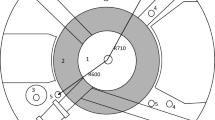Abstract
A series of investigations studying the currents of rhodium sensors in in-reactor monitoring systems and the relation between the currents and the energy release in the fuel elements in the nearest neighbor environment in a VVÉR-1000 fuel assembly model was completed in 2001–2002 at the Russsian Science Center Kurchatov Institute. The experiments were performed on the SK-fiz critical test stand; the calculations were performed using the high precision MCU-REA/2 computer program, implementing the Monte Carlo method. The reference experimental-computational method for determining the relation between the DCD current and the number of fissions in the six neighboring fuel elements and fuel assembly is described, the effects due to the arrangement of the DCDs at the center and in the fourth row of the fuel assembly are studied, and the experimental data are compared with the computational results.
The possibilities of the only high-flux critical test stand in the industry are demonstrated (the thermal-neutron flux density 1011 sec–1·cm–2, high accuracy of the experimental and computational methods). The SK-fiz stand and the high precision MCU-REA/2 computer program make it possible to perform comprehensive and detailed investigations of the relationship between the DCD current and the local and integral energy release in fuel assemblies.
Similar content being viewed by others
REFERENCES
I. N. Aborina, V. Yu. Aborin, Yu. A. Epanechnikov, et al., “Possibilities of experimental stand system of the VVÉR division of the Institute of Nuclear Reactors at the Russian Science Center Kurchatov Institute for studying SVRK sensors for VVÉR reactors,” Report No. 12, Proceedings of the 2nd International Symposium on Measurements Important for Reactor Safety, Moscow, September 10–12, 2002.
N. I. Alekseev, I. N. Aborina, V. Yu. Aborin, et al., “Experimental-computational investigations of the energy release and DCD currents in a model VVÉR-1000 fuel assembly,” Report No. 13, Proceedings of the 2nd International Symposium on Measurements Important for Reactor Safety.
MCU-REA Computer Program System with the DLC/MCUDAT-2.1 Constants Library. Certification certificate for software, Software registration number in TsÉP No. 429, December 18, 1998. Registration number of the software certification certificate No. 115, March 2, 2000. Russian Federal Inspection Agency for Nuclear and Radiation Safety, Moscow (2000).
L. V. Majorov, E. A. Gomin, and M. I. Gurevich, “Status of MCU,” in: Proceedings of International Conference on Advanced Monte Carlo on Radiation Physics, Particle Transport Simulation, and Applications. Program and Book of Abstracts, pp. 203–204, Lisbon, Portugal, October 23–26, 2000.
S. S. Gorodkov, “Application of the Monte Carlo method for calculating the activation current of a rhodium neutron detector,” At. Énerg., 92, No. 1, 18–22 (2002).
“Reference neutron field,” Certification Certificate No. 46008.2 I004, No. 46008.2 I005, August 5, 2002. State Scientific Metrological Center “VNIIFTRI,” Gostandarta Rossii, Mendeleevo (2002).
“Standard radiometric measurement system IKÉ-II-28,” Certification Certificate No. 46108.2 I007, August 5, 2002. State Scientific Metrological Center “VNIIFTRI,” Gostandarta Rossii, Mendeleevo (2002).
Author information
Authors and Affiliations
Rights and permissions
About this article
Cite this article
Aborina, I.N., Aborin, V.Y., Alekseev, N.I. et al. Measurement of the Absolute Power of a Fuel Assembly and Current by Direct-Charge Detectors on a SK-fiz Critical Test Stand. Atomic Energy 93, 790–799 (2002). https://doi.org/10.1023/A:1022077310358
Issue Date:
DOI: https://doi.org/10.1023/A:1022077310358




